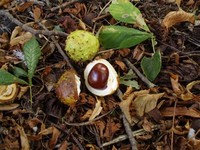Facts about Chestnuts

Chestnuts, given their tendency to fall near the parent tree due to being heavy, rely on dispersal agents to provide effective dispersal of seeds.

Chestnuts also serve as an important ornamental tree and timber resource.

Another little known use is to eat chestnuts raw by just peeling them (almost unknown in North-America but customary at least in Northwest Europe).

Candied chestnuts are often sold under the French name marrons glacйs or Turkish name kestane ?ekeri.

The chestnuts, genus Castanea, are mostly species with large trees growing to 20-40 meters tall, but some species (the chinkapins) are smaller, often shrubby.

On alkaline soils, chestnuts can be grown by grafting them onto oak rootstocks.

Chestnuts also have been a traditional staple food: In southern Europe in the Middle Ages, whole forest-dwelling communities that had scarce access to wheat flour relied on chestnuts as their main source of carbohydrates.

The young chestnuts are protected by a burr that is formidable, but it opens wide when the seed is ripe (Paillet 2005).

Chestnuts are largely starch and water, with very little fat, and are a good source of dietary fiber and copper and a source of vitamins B1 and B6 (Bender and Bender 2005).

Chestnuts grown for commercial nut production are grown in orchards with wide spacing between the trees to encourage low, broad crowns with maximum exposure to sunshine to increase nut production.

Chestnuts start to degrade if they are left out for more than five to seven days.

Eight or nine species have been identified as part of Castanea, including those chestnuts commonly called chinkapins, which typically are smaller, often more shrubby, than the other species of large trees.

Chestnuts for planting require storage in moist sand and chilling over the winter before sowing; drying kills the seed and prevents germination.

Humans also consume chestnuts, as reflected in the holiday song whose opening verse reads "Chestnuts roasting on an open fire."

Chestnuts' taste may vary slightly from one to the next but is somewhat sweet and certainly unique.

Another important use of chestnuts is to be ground into flour, which can then be used to prepare bread, cakes, and pasta.

A fungal disease, chestnut blight Cryphonectria parasitica, affects chestnuts.

